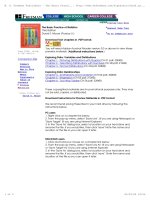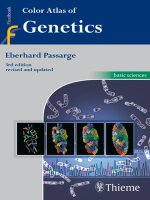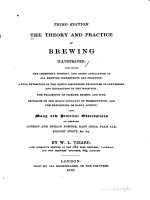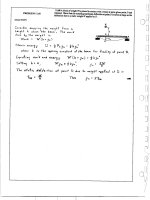Washington manual of rheumatology 3rd ed subspeciality consult
Bạn đang xem bản rút gọn của tài liệu. Xem và tải ngay bản đầy đủ của tài liệu tại đây (6.9 MB, 649 trang )
THE WASHINGTON MANUAL™
Rheumatology
Subspecialty Consult
Second Edition
Editors
Leslie E. Kahl, MD
Professor of Medicine
Department of Internal Medicine
Division of Rheumatology
Washington University School of Medicine
St. Louis, Missouri
Series Editors
Thomas M. De Fer, MD
Professor of Internal Medicine
Washington University School of Medicine
St. Louis, Missouri
Katherine E. Henderson, MD
Assistant Professor of Clinical Medicine
Department of Medicine
Division of Medical Education
Washington University School of Medicine
Barnes-Jewish Hospital
St. Louis, Missouri
2
3
Senior Acquisitions Editor: Sonya Seigafuse
Senior Product Manager: Kerry Barrett
Vendor Manager: Bridgett Dougherty
Senior Marketing Manager: Kimberly Schonberger
Manufacturing Manager: Ben Rivera
Design Coordinator: Stephen Druding
Editorial Coordinator: Katie Sharp
Production Service: Aptara, Inc.
© 2012 by Department of Medicine, Washington University School of Medicine
Printed in China
All rights reserved. This book is protected by copyright. No part of this book may be reproduced in any form by
any means, including photocopying, or utilized by any information storage and retrieval system without written
permission from the copyright owner, except for brief quotations embodied in critical articles and reviews.
Materials appearing in this book prepared by individuals as part of their official duties as U.S. government
employees are not covered by the above-mentioned copyright.
Library of Congress Cataloging-in-Publication Data
The Washington manual rheumatology subspecialty consult. — 2nd ed. /editor, Leslie E. Kahl.
p. ; cm.
Rheumatology subspecialty consult
Includes bibliographical references and index.
ISBN 978-1-4511-1412-6 (alk. paper) — ISBN 1-4511-1412-5 (alk. paper)
I. Kahl, Leslie E. II. Title: Rheumatology subspecialty consult.
[DNLM:
1. Rheumatic Diseases—diagnosis—Handbooks.
2. Rheumatic Diseases—therapy—
Handbooks. WE 39]
616.723—dc23
2012004717
The Washington Manual™ is an intent-to-use mark belonging to Washington University in St. Louis to which
international legal protection applies. The mark is used in this publication by LWW under license from Washington
University.
Care has been taken to confirm the accuracy of the information presented and to describe generally accepted
practices. However, the authors, editors, and publisher are not responsible for errors or omissions or for any
consequences from application of the information in this book and make no warranty, expressed or implied, with
respect to the currency, completeness, or accuracy of the contents of the publication. Application of the
information in a particular situation remains the professional responsibility of the practitioner.
The authors, editors, and publisher have exerted every effort to ensure that drug selection and dosage set forth
in this text are in accordance with current recommendations and practice at the time of publication. However, in
view of ongoing research, changes in government regulations, and the constant flow of information relating to drug
therapy and drug reactions, the reader is urged to check the package insert for each drug for any change in
indications and dosage and for added warnings and precautions. This is particularly important when the
recommended agent is a new or infrequently employed drug.
Some drugs and medical devices presented in the publication have Food and Drug Administration (FDA)
clearance for limited use in restricted research settings. It is the responsibility of the health care provider to
ascertain the FDA status of each drug or device planned for use in their clinical practice.
To purchase additional copies of this book, call our customer service department at (800) 638-3030 or fax orders
4
to (301) 223-2320. International customers should call (301) 223-2300.
Visit Lippincott Williams & Wilkins on the Internet: at LWW.com. Lippincott Williams & Wilkins customer
service representatives are available from 8:30 am to 6 pm, EST.
10 9 8 7 6 5 4 3 2 1
5
Contributing Authors
Zarmeena Ali, MD
Fellow
Department of Internal Medicine
Division of Rheumatology
Washington University School of Medicine
St. Louis, Missouri
Amy Archer, MD
Resident
Department of Internal Medicine
Division of Rheumatology
Washington University School of Medicine
St. Louis, Missouri
John P. Atkinson, MD
Samuel Grant Professor of Medicine
Department of Internal Medicine
Division of Rheumatology
Washington University School of Medicine
St. Louis, Missouri
Rebecca Brinker, MD
Fellow
Department of Internal Medicine
Division of Rheumatology
Washington University School of Medicine
6
St. Louis, Missouri
Lesley Davila, MD
Fellow
Department of Internal Medicine
Division of Rheumatology
Washington University School of Medicine
St. Louis, Missouri
Maria C. Gonzalez-Mayda, MD
Fellow
Department of Internal Medicine
Division of Rheumatology
Washington University School of Medicine
St. Louis, Missouri
Richa Gupta, MD
Fellow
Department of Internal Medicine
Division of Rheumatology
Washington University School of Medicine
St. Louis, Missouri
Amy Joseph, MD
Associate Professor of Medicine
Department of Internal Medicine
Division of Rheumatology
Washington University School of Medicine
St. Louis VA Medical Center
St. Louis, Missouri
7
Reeti Joshi, MD
Fellow
Department of Internal Medicine
Division of Rheumatology
Washington University School of Medicine
St. Louis, Missouri
Leslie E. Kahl, MD
Professor of Medicine
Department of Internal Medicine
Division of Rheumatology
Washington University School of Medicine
St. Louis, Missouri
Alfred H. J. Kim, MD, PhD
Instructor in Medicine
Department of Internal Medicine
Division of Rheumatology
Washington University School of Medicine
St. Louis, Missouri
Ashwini Komarla, MD
Resident
Department of Internal Medicine
Division of Rheumatology
Washington University School of Medicine
St. Louis, Missouri
Kristine A. Kuhn, MD, PhD
Fellow
8
Department of Internal Medicine
Division of Rheumatology
Washington University School of Medicine
St. Louis, Missouri
Hyon Ju Park, MD
Fellow
Department of Internal Medicine
Division of Rheumatology
Washington University School of Medicine
St. Louis, Missouri
Prabha Ranganathan, MD
Associate Professor of Medicine
Department of Internal Medicine
Division of Rheumatology
Washington University School of Medicine
St. Louis, Missouri
Michael L. Sams, MD
Fellow
Department of Internal Medicine
Division of Rheumatology
Washington University School of Medicine
St. Louis, Missouri
Jeffrey Sparks, MD
Resident
Department of Internal Medicine
Division of Rheumatology
9
Washington University School of Medicine
St. Louis, Missouri
Wayne M. Yokoyama, MD
Sam and Audrey Loew Levin Professor of
Medicine
Department of Internal Medicine
Division of Rheumatology
Washington University School of Medicine
St. Louis, Missouri
10
Chairman’s Note
is a pleasure to present the new edition of The Washington Manual ®
I tSubspecialty
Consult Series: Rheumatology Subspecialty Consult. This pocketsize book continues to be a primary reference for medical students, interns,
residents, and other practitioners who need ready access to practical clinical
information to diagnose and treat patients with a wide variety of disorders. Medical
knowledge continues to increase at an astounding rate, which creates a challenge for
physicians to keep up with the biomedical discoveries, genetic and genomic
information, and novel therapeutics that can positively impact patient outcomes. The
Washington Manual Subspecialty Series addresses this challenge by concisely and
practically providing current scientific information for clinicians to aid them in the
diagnosis, investigation, and treatment of common medical conditions.
I want to personally thank the authors, which include house officers, fellows, and
attendings at Washington University School of Medicine and Barnes-Jewish
Hospital. Their commitment to patient care and education is unsurpassed, and their
efforts and skill in compiling this manual are evident in the quality of the final
product. In particular, I would like to acknowledge our editor, Dr. Leslie Kahl, and
the series editors, Drs. Tom De Fer and Katherine Henderson, who have worked
tirelessly to produce another outstanding edition of this manual. I would also like to
thank Dr. Melvin Blanchard, Chief of the Division of Medical Education in the
Department of Medicine at Washington University School of Medicine, for his
advice and guidance. I believe this Subspecialty Manual will meet its desired goal
of providing practical knowledge that can be directly applied at the bedside and in
outpatient settings to improve patient care.
Victoria J. Fraser, MD
Dr. J. William Campbell Professor
Interim Chairman of Medicine
Co-Director of the Infectious Disease Division
Washington University School of Medicine
11
Preface
have written this manual as a guide to inpatient and outpatient rheumatology
W econsultations.
The target audience includes medical students, residents, and
other medical professionals who care for patients with rheumatologic problems. In
addition, this manual could also serve as a pocket reference for medical
professionals specializing in rheumatology. It is not intended as a compendium of
rheumatology but, rather, focuses on how to approach rheumatologic problems. As
such, it provides guidance on how to perform the musculoskeletal examination and
arthrocentesis, what laboratory testing may prove useful, and which medications are
appropriate (including dosages and recommended monitoring), all framed within a
brief overview of the major rheumatologic diseases.
The editor would like to thank the contributing authors for their participation in
this project. A special thanks goes to Dr. Tom De Fer for his ongoing support and
oversight, and to the authors and editors of the first edition of the manual for leading
the way.
L.E.K
12
Contents
Contributing Authors
Chairman’s Note
Preface
PART I. INTRODUCTION TO THE RHEUMATOLOGY
CONSULT
1. Approach to the Rheumatology Patient
Maria C. Gonzalez-Mayda and Leslie E. Kahl
2. Rheumatologic Joint Examination
Michael L. Sams and Leslie E. Kahl
3. Arthrocentesis: Aspirating and Injecting Joints and Bursa
Rebecca Brinker and Leslie E. Kahl
4. Synovial Fluid Analysis
Jeffrey Sparks and Leslie E. Kahl
5. Laboratory Evaluation of Rheumatic Diseases
Kristine A. Kuhn and Leslie E. Kahl
6. Radiographic Imaging of Rheumatic Diseases
Ashwini Komarla and Leslie E. Kahl
7. Rheumatologic Emergencies
Reeti Joshi and Leslie E. Kahl
8. Regional Pain Syndromes
Michael L. Sams and Leslie E. Kahl
9. Drugs Used for the Treatment of Rheumatic Diseases
Alfred H.J. Kim and Leslie E. Kahl
13
PART II. COMMON RHEUMATIC DISEASES
10. Rheumatoid Arthritis
Richa Gupta and Prabha Ranganathan
11. Osteoarthritis
Hyon Ju Park and Prabha Ranganathan
12. Systemic Lupus Erythematosus
Alfred H.J. Kim and Wayne M. Yokoyama
PART III. CRYSTALLINE ARTHRITIS
13. Gout
Richa Gupta and Wayne M. Yokoyama
14. Calcium Pyrophosphate Dihydrate Crystal Deposition Disease
Amy Archer and Wayne M. Yokoyama
PART IV. SPONDYLOARTHROPATHIES
15. Undifferentiated Spondyloarthritis
Kristine A. Kuhn and Wayne M. Yokoyama
16. Ankylosing Spondylitis
Lesley Davila and Wayne M. Yokoyama
17. Psoriatic Arthritis
Amy Archer and Wayne M. Yokoyama
18. Reactive Arthritis
Reeti Joshi and Wayne M. Yokoyama
19. Enteropathic Arthritis
Kristine A. Kuhn and Wayne M. Yokoyama
PART V. VASCULITIS
14
20. Vasculitis
Alfred H.J. Kim and John P. Atkinson
21. Takayasu’s Arteritis
Michael L. Sams and John P. Atkinson
22. Giant Cell Arteritis and Polymyalgia Rheumatica
Alfred H.J. Kim and John P. Atkinson
23. Polyarteritis Nodosa
Maria C. Gonzalez-Mayda and John P. Atkinson
24. Wegener’s Granulomatosis
Jeffrey Sparks and John P. Atkinson
25. Churg–Strauss Syndrome
Lesley Davila and John P. Atkinson
26. Microscopic Polyangiitis
Kristine A. Kuhn and John P. Atkinson
27. Henoch–Schönlein Purpura
Amy Archer and John P. Atkinson
28. Cryoglobulinemia and Cryoglobulinemic Vasculitis
Reeti Joshi and John P. Atkinson
29. Cutaneous Vasculitis
Michael L. Sams and John P. Atkinson
30. Thromboangiitis Obliterans
Rebecca Brinker and John P. Atkinson
31. Behçet’s Disease
Maria C. Gonzalez-Mayda and John P. Atkinson
PART VI. INFECTION AND RELATED DISORDERS
15
32. Infectious Arthritis
Jeffrey Sparks and Prabha Ranganathan
33. Lyme Disease
Rebecca Brinker and Prabha Ranganathan
34. Acute Rheumatic Fever
Jeffrey Sparks and Prabha Ranganathan
PART VII. OTHER RHEUMATIC DISORDERS
35. Inflammatory Myopathies
Hyon Ju Park and Prabha Ranganathan
36. Fibromyalgia Syndrome
Lesley Davila and Amy Joseph
37. Sjögren’s Syndrome
Maria C. Gonzalez-Mayda and Amy Joseph
38. Scleroderma
Hyon Ju Park and Amy Joseph
39. Antiphospholipid Syndrome
Lesley Davila and Amy Joseph
40. Mixed Connective Tissue Disease
Reeti Joshi and Amy Joseph
41. Undifferentiated Connective Tissue Disease
Rebecca Brinker and Amy Joseph
42. Adult-Onset Still’s Disease
Amy Archer and John P. Atkinson
43. Relapsing Polychondritis
Lesley Davila and John P. Atkinson
16
44. Deposition and Storage Arthropathies
Hyon Ju Park and Zarmeena Ali
45. Sarcoid Arthropathy
Lesley Davila and Leslie E. Kahl
46. Amyloidosis and Amyloid Arthropathy
Rebecca Brinker and Zarmeena Ali
47. Miscellaneous Skin Conditions
Reeti Joshi, Zarmeena Ali, and Leslie E. Kahl
48. Osteoporosis
Ashwini Komarla, Richa Gupta, and Zarmeena Ali
49. Avascular Necrosis
Richa Gupta, Ashwini Komarla, and Zarmeena Ali
50. Hereditary Periodic Fever Syndromes
Hyon Ju Park and John P. Atkinson
Index
17
1
Approach to the Rheumatology Patient
Maria C. Gonzalez-Mayda and
Leslie E. Kahl
GENERAL PRINCIPLES
• Musculoskeletal conditions may be classified according to their symptom
presentation, that is, inflammatory versus noninflammatory and articular versus
nonarticular.
• A thorough history and physical examination is necessary in order to help
narrow your diagnosis.
• Use specific ancillary tests such as radiographs, labs, and arthrocentesis to
help confirm your initial diagnosis.
• Rheumatic diseases mainly involve the musculoskeletal system.
Inflammatory disorders are often accompanied by systemic features (fever
and weight loss) and other organ involvement (kidney, skin, lung, eye,
blood).
Since these diseases affect multiple organ systems, they are therefore
challenging to diagnose, complicated to treat, and often humbling to study.
• Musculoskeletal complaints account for a majority of outpatient visits in the
community.
Many are self-limited or localized problems that improve with symptomatic
treatment.
Other conditions (e.g., septic arthritis, crystal-induced arthritis, fractures)
require urgent diagnosis and treatment.
• Musculoskeletal problems may also be the initial presentation of diseases such
as cancer and endocrinopathies.
• Inpatient consultations usually involve patients with known diagnoses (a patient
with lupus admitted with a flare) or with multiple organ system involvement
and the suspicion of a systemic rheumatic disease (a patient with respiratory
and kidney failure with positive antineutrophil cytoplasmic antibody [ANCA]).
18
Classification
The following is an approach to patients with musculoskeletal complaints and to
common inpatient consults. Regional problems (i.e., nonsystemic musculoskeletal
disorders) are discussed in Chapter 8, Regional Pain Syndromes.
Inflammatory versus Noninflammatory
The characteristics of inflammatory and noninflammatory disorders are presented in
Table 1-1.
• Inflammatory disorders
Characterized by systemic symptoms (fever, stiffness, weight loss, fatigue).
Signs of joint inflammation on physical examination (erythema, warmth,
swelling, pain).
TABLE 1-1 NONINFLAMMATORY VERSUS INFLAMMATORY
DISORDERS
Lab evidence of inflammation (elevated erythrocyte sedimentation rate
[ESR], elevated C-reactive protein [CRP], hypoalbuminemia, normochromic
normocytic anemia, thrombocytosis).
Joint stiffness is common after prolonged rest (morning stiffness) and
improves with activity.
Duration of >1 hour suggests an inflammatory condition.
Noninflammatory conditions may cause stiffness usually lasting <1 hour
19
and the joint symptoms increase with use and weight bearing.
These distinctions are useful but not absolute.
Inflammatory disorders may be immune-mediated (systemic lupus
erythematosus [SLE], rheumatoid arthritis [RA]), reactive (reactive arthritis
[ReA]), infectious (gonococcal [GC] arthritis), or crystal induced (gout,
pseudogout).
• Noninflammatory disorders
Characterized by absence of systemic symptoms, pain without erythema or
warmth, normal lab tests.
Osteoarthritis (OA), fibromyalgia, and traumatic conditions are common
noninflammatory disorders.
Articular versus Nonarticular
• Pain may originate from:
Articular structures (synovial membrane, cartilage, intra-articular
ligaments, capsule, or juxtaarticular bone surfaces).
Periarticular structures (bursae, tendons, muscle, bone, nerve, skin).
Nonarticular structures (i.e., cardiac pain referred to the shoulder).
• Articular disorders
Cause deep or diffuse pain that worsens with active and passive movement.
Physical examination may show deformity, warmth, swelling, effusion, or
crepitus.
Synovitis (inflammation of the synovial membrane that covers the joint) is
a boggy, tender swelling around the joint. The joint loses its sharp edges
on examination. Synovitis is easy to detect in finger and wrist joints.
Arthralgia refers to joint pain without abnormalities on joint examination.
Arthritis indicates the presence of abnormality in the joint (warmth,
swelling, erythema, tenderness).
• Nonarticular disorders
Usually have point tenderness and increased pain with active, but not
passive, movement.
Physical examination does not usually show joint deformity or swelling.
20
DIAGNOSIS
Clinical Presentation
• The evaluation of musculoskeletal complaints should determine whether the
disorder is inflammatory or noninflammatory, whether the joints or the
periarticular structures are involved, and the number and pattern of joints
involved.
• Number and pattern of joints involved:
The number and pattern of joints involved are important in the diagnosis.
Acute monoarthritis suggests infection but gout and trauma are possible.
Asymmetric, oligoarticular (<5 joints) involvement, particularly of the
lower extremities, is typical of OA and ReA.
Symmetric, polyarticular (≥5 joints) involvement is typical of RA and SLE.
Involvement of the spine, sacroiliac (SI) joints, and sternoclavicular joints
is characteristic of ankylosing spondylitis (AS).
In the hands, distal interphalangeal (DIP) joints are involved in OA
(Heberden’s nodes) and in psoriatic arthritis (PsA) but are spared by RA.
Proximal interphalangeal (PIP) joint involvement is seen in OA
(Bouchard’s nodes) and RA.
Metacarpophalangeal (MCP) joints are involved in RA but not in OA.
Acute first metatarsophalangeal (MTP) joint arthritis is classic for gout
(podagra) but is also seen in OA and ReA.
Vasculitis and SLE may present with multiple organ system involvement,
often without major joint complaints.
Fibromyalgia presents with diffuse pain but without arthritis.
Myositis presents with muscle weakness and rashes and occasionally
peripheral arthritis.
History
• A comprehensive history and physical examination are often enough to make a
diagnosis.
• Ask about pain, swelling, weakness, tenderness, limitation of motion, stiffness,
as well as constitutional symptoms when presented with a musculoskeletal
21
complaint since these clues will help you narrow your diagnosis.
For example, joint pain that occurs at rest and which worsens with movement
suggests an inflammatory process versus pain elicited with activity and
relieved by rest usually indicates a mechanical disorder such as a
degenerative arthritis.
• Inquire about what medications they are taking since many have side effects
and patients on immunosuppressive drugs are predisposed to developing
infections.
Some medications may cause a lupus-like syndrome (e.g., hydralazine,
procainamide), myopathies (e.g., statins, colchicine, zidovudine), or
osteoporosis (e.g., corticosteroids, phenytoin).
Alcohol commonly precipitates gout and may rarely cause myopathies and
avascular necrosis (AVN).
Vasculitis, arthralgias, and rhabdomyolysis may also be seen with substance
abuse (e.g., cocaine, heroin).
• Certain areas of the United States and Europe have an increased incidence of
Lyme disease; therefore, it is important to inquire about recent trips to these
areas.
• A family history may be important in AS, gout, and OA.
• The review of systems may identify other organ involvement and support the
diagnosis.
The nervous system may be involved in SLE, vasculitis, and Lyme disease.
Eye involvement may be severe and occurs in Sjögren’s syndrome (SS), RA,
seronegative spondyloarthropathies, giant cell arthritis, Behçet’s disease,
and Wegener’s granulomatosis (WG).
Oral mucosal ulcers are common in SLE, enteropathic arthritis, and Behçet’s
disease.
Rashes are seen in SLE, vasculitis, PsA, dermatomyositis (DM), adult-onset
Still’s disease, and Lyme disease.
Raynaud’s phenomenon is a reversible, paroxysmal constriction of small
arteries that occurs most commonly in fingers and toes and is precipitated by
cold. The classic sequence is initial blanching followed by cyanosis and
finally erythema due to vasodilation and is accompanied by numbness or
tingling. It may be idiopathic or associated with scleroderma, SLE, RA, and
mixed connective tissue disease (MCTD).
22
Pleuritis and pericarditis may be seen in RA, SLE, MCTD, and adult-onset
Still’s disease.
Gastrointestinal (GI) involvement is seen in enteropathic arthritis;
polymyositis (PM), and scleroderma. The latter may be associated with
dysphagia.
• Certain diseases are more frequent in specific age groups and genders.
SLE, juvenile RA, and GC arthritis are more common in the young.
Gout, OA, and RA are more common in middle-aged persons.
Polymyalgia rheumatica (PMR) and giant cell arthritis occur in the elderly.
Gout and AS are more common in men; gout is rare in premenopausal
women.
SLE, RA, and OA are more common in women.
Physical Examination
• Tailor the physical examination based on the presenting complaint.
• If the main complaint is arthritis or arthralgia, look for signs of inflammation
such as swelling, warmth, erythema over the joint and surrounding structures,
tenderness, deformity, limitation of motion, instability of the joint, and crepitus.
• If the pain appears to be nonarticular in origin, examine the surrounding bursae,
tendons, ligaments and bones for tenderness and inflammation.
• If there is suspicion of systemic involvement, make sure to perform a thorough
examination from head to toe so as not to miss any important findings that could
help you determine the etiology of their symptoms.
Examine the hair for signs of alopecia and or rashes.
The skin for any type of discoloration, rash, ulceration, blistering as well as
the nails for pitting.
The nose and mouth for signs of ulceration.
The heart and lungs for signs of pericardial and or pleural rubs, and/or
decreased breath sounds from underlying pulmonary fibrosis.
The abdomen for signs of serositis, pain related to ischemic bowel, etc.
A thorough examination of all the joints to look for the signs mentioned
above.
Examine the back thoroughly at the spinous processes, paraspinal and
23
surrounding muscles. Do not forget to examine the SI joints as well.
If there is clinical suspicion for Behçet’s disease and/or inflammatory bowel
disease, a genital examination would be indicated since ulcerations can be
seen.
Differential Diagnosis
Approach to Monoarthritis
• Common causes of monoarthritis are infection, crystal-induced arthritis, and
trauma (Table 1-2).
• Acute pain or swelling of a single joint requires immediate evaluation for
septic arthritis that can rapidly destroy the joint if left untreated (Fig. 1-1).
• It is also important to distinguish pain arising from periarticular structures
(tendons, bursa), which usually requires only symptomatic treatment, and cases
of referred pain (shoulder pain due to peritonitis or heart disease).
• The history should exclude trauma and can provide clues such as:
History of tick bite (Lyme disease).
Sexual risk factors (GC arthritis).
Colitis, uveitis, and urethritis (ReA).
• Physical examination usually distinguishes between articular and nonarticular
disorders.
• Perform arthrocentesis in patients with acute monoarthritis (see Chapter 4,
Synovial Fluid Analysis). Send synovial fluid for:
Leukocyte count with differential (>2000/mm3 suggest an inflammatory
process).
Gram stain and culture.
Crystal analysis. A wet mount of the fluid examined under polarizing
microscopy may identify crystals, but the presence of crystals does not
exclude infection.
• Culture other potential sources of infection (throat, cervix, rectum, wounds,
blood).
• Synovial biopsy and arthroscopy are sometimes used to diagnose chronic
monoarthritis.
24
• Radiographs are useful in cases of trauma and may show OA or
chondrocalcinosis in calcium pyrophosphate deposition disease.
• A patient with synovial fluid that is highly inflammatory requires empiric
antibiotic therapy until the evaluation, including cultures, is completed.
TABLE 1-2 FEATURES AND CAUSES OF MONOARTHRITIS
Approach to Polyarthritis
• Polyarthritis is one of the most common problems in rheumatology (Fig. 1-2).
• The number and pattern of joint involvement suggest the diagnosis (Table 1-3).
• There are many nonarticular causes of generalized joint pain.
Disorders of periarticular structures (tendons, bursae) cause joint pain but
usually involve a single joint.
25









